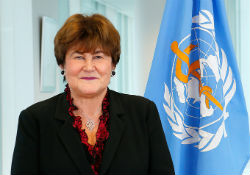Statement – Removing the disguise – plain tobacco packs reduce the appeal of smoking

WHO
31-05-2016
Plain packaging is the theme of World No Tobacco Day 2016 – Regional Director Dr Zsuzsanna Jakab welcomes the leadership of the European Region in considering tougher packaging laws for tobacco products.
Statement by Dr Zsuzsanna Jakab, WHO Regional Director for Europe
There is growing momentum in Europe towards a tobacco-free future. But getting to that point involves making tough decisions and requires strong leadership. In the WHO European Region, Finland, Ireland and Scotland have set the bold goal of having smokers comprise only 5% or less of their populations. Achieving this goal means signing up to policies and measures that are known to be effective. Plain packaging is one such measure.
Industry uses the tobacco pack as a powerful advertising tool, thus avoiding marketing restrictions. Plain packaging of tobacco products encourages more people to quit and fewer to start. It follows the success of banning point-of-sale displays in reducing the attractiveness of tobacco products to young people. It strips away the illusion of glamour and unveils the reality of a product that kills.
Effective plain packaging should not be seen as a stand-alone intervention but as part of a comprehensive approach to tobacco control, which includes bans on tobacco advertising, promotion and sponsorship and other packaging and labelling measures, such as large, graphic health warnings. In the European Region, France and the United Kingdom are taking the lead in introducing plain packaging as an important step on the way towards a tobacco-free future.
What is plain packaging?
The guidelines for implementation of Article 11 (Packaging and labelling of tobacco products) of the WHO Framework Convention on Tobacco Control (WHO FCTC) define plain packaging as "measures to restrict or prohibit the use of logos, colours, brand images or promotional information on packaging other than brand names and product names displayed in a standard colour and font style". Put simply, there should be no advertising or promotion inside or attached to the package, on individual cigarettes or on other tobacco products.
The phrase "standardized packaging" is used interchangeably with "plain packaging". Those who prefer the phrase "standardized packaging" argue that packaging bearing large graphic health warnings is not actually "plain". Graphic health warnings are a separate policy that can be used with plain packaging to warn consumers about the risks associated with tobacco consumption.
What does plain packaging do?
Plain packaging is an evidence-based measure for improving public health by: reducing the attractiveness of tobacco products, eliminating the effects of tobacco packaging as a form of advertising and promotion, removing package design techniques that suggest that some products are less harmful than others and increasing the noticeability and effectiveness of health warnings.
Are there success stories?
Evidence from Australia, where plain packaging has been in effect since 2012, shows that it works. The introduction of plain packaging effectively reinforced the 25% tax increase instituted in 2010. Australian law now requires that tobacco products be sold in simple packages with large graphic images of the effects of tobacco-related diseases. They can include the brand name but no logos. Studies conducted after the introduction of plain packaging have shown that more smokers wish to quit, there are more calls to the Quitline and more quit attempts. Fewer consumers wrongly believe that brands differ in harmfulness, and there are indications that health warnings have become more effective among smokers. Australia is not a laboratory experiment but a real-life experience that shows that plain packaging reduces smoking. Australia's daily smoking rate among people aged 14 years and older decreased by 15% in the 3 years between 2010 and 2013.
Can tobacco control support sustainable development?
The Sustainable Development Goals call for accelerated implementation of the WHO FCTC, which is considered to have an essential role in fulfilling the world's overarching development agenda. Notably, tobacco consumption has a negative effect on economic development, as it diverts household expenditure from food, health care and education. It also results in substantial economic costs in terms of health expenditure and lost productivity, with the heaviest impact in developing countries.
On World No Tobacco Day, WHO calls on the countries of the European Region and the world to get ready for plain packaging of tobacco products. This is an important measure that will help reduce the demand for tobacco and also support the achievement of major health and development goals.



